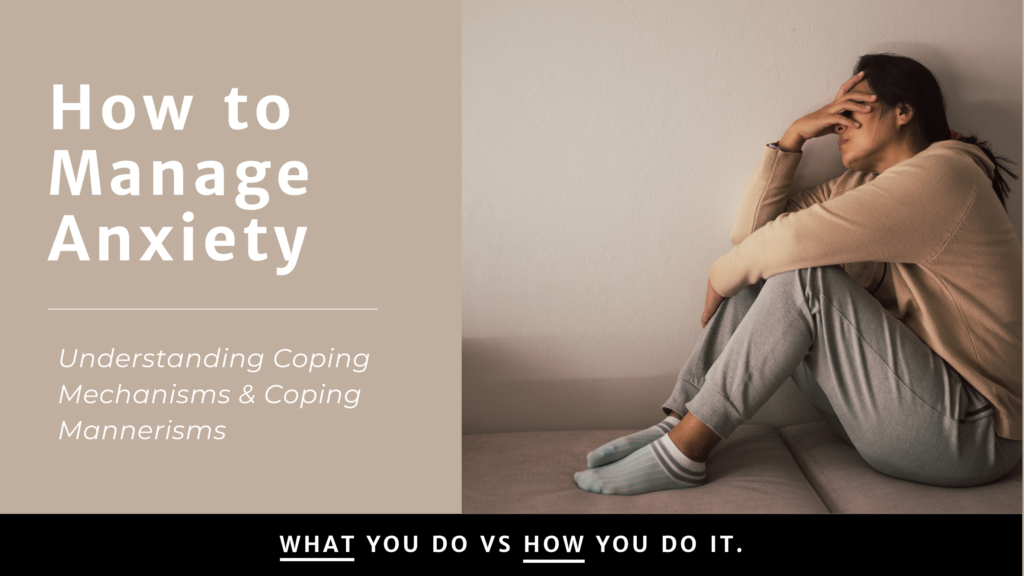
How to Manage Anxiety : Understanding Coping Mechanisms & Coping Mannerisms
- Vincent Yong
- November 15, 2024
Anxiety is a heightened state of worry or fear, often about future events or uncertainties. In anxiety, persisting experiences such as excessive worry, fear, feeling tensed, restlessness, heart palpitations, nausea or sense of impending doom persists amongst other things. Your coping mechanisms and coping mannerisms for anxiety can have a significant impact on how you manage and potentially reduce your feeling of anxiety.
Most of us have heard or know about coping mechanism. But what is not mentioned usually is our coping mannerism.
Understanding Coping Mechanisms and Coping Mannerisms
What Are Coping Mechanisms?
Coping mechanism, is what people do to alleviate their anxiety. These mechanisms can be constructive or unconstructive in nature.
Constructive coping mechanisms can help reduce anxiety in healthy ways, promote emotional well-being,They include:
- Mindfulness and Meditation: Practicing mindfulness or meditation helps ground you in the present moment, reduce racing thoughts, and lower stress hormones.
- Exercise: Physical activity releases endorphins, reduces stress, and can improve overall mood and energy levels.
- Deep Breathing and Relaxation Exercises: Techniques like deep breathing, progressive muscle relaxation, and visualization can help calm the nervous system.
- Time Management and Goal Setting: Breaking tasks into manageable steps and setting realistic goals can reduce overwhelming feelings and help you to feel more in control.
- Seeking Social Support: Talking to trusted friends, family, or a therapist provides emotional support and reduces feelings of isolation.
- Problem-Solving and Cognitive Restructuring: Identifying specific triggers of anxiety and re-framing negative thoughts helps build resilience and a healthier mindset.
- Art Therapy: Creative expression helps individuals process emotions, manage stress, and gain insight into their thoughts and behaviors.
- Dance Therapy: Expressive movement promotes emotional, physical, and psychological well-being.
Unconstructive coping mechanisms often provide temporary relief but can worsen anxiety in the long term. These include:
- Avoidance: Avoiding anxiety-inducing situations or responsibilities might provide short-term relief but can increase anxiety over time and reduce confidence in facing challenges.
- Substance Abuse: Using alcohol, drugs, or excessive caffeine to cope can lead to dependency, worsen anxiety symptoms, and impact physical health.
- Procrastination: Putting off tasks due to anxiety often leads to increased stress and guilt, making situations feel even more overwhelming.
- Compulsive Behaviors: Activities like overeating, excessive shopping, or binge-watching can distract from anxiety temporarily but may not address underlying issues.
- Self-Criticism and Negative Thinking: Constant self-criticism or expecting the worst only reinforces negative thought patterns, often making anxiety worse.
What Are Coping Mannerisms?
Coping mechanism, is HOW you do what you do to alleviate your anxiety. A constructive coping mechanism can be made more effective or ineffective based on your coping manners.
Example 1: While running…
Take for example while going for a run (a supposedly constructive coping mechanism; exercise), if you are feeling anxious, and to overcome the feeling you start running faster and faster, with thoughts still racing in your head and emotions all over. Instead of doing good, it might cause you to lose awareness of your body and space leading to trips and falls if you get progressively riled up emotionally. And if this manner of running is practised over time, the action of running and the emotion are associated and somatised. You might end up changing to another modality (again) to cope with the anxiety thinking it wasn’t helpful.
However, if you are able to work through the process starting with your breathing and with every move you make, you become more connected with your body and it draws you away from your racing thoughts. You can then begin to calm down and direct your attention to your heart rate and tuning into the speed of your heart rate for example. “Is the heart beating faster or slower?”… “Am I feeling better or not?” Thus, it brings you back to being present in your body and in the space you are in rather than get yourself subsumed by the mind.
Example 2: Managing your time and breaking tasks into manageable steps…
Let us take time management as another example on “how” you can manage it better. Many people often give themselves a time frame to complete a task. While that is good, the way they try to fit too many things into that frame can often cause them to feel anxious and hurried. This can often lead to them unconsciously holding their breaths, or engaged only in shallow breathing to brace themselves against the build up of the stress they are experiencing.
Time management is more than just making time work for you. It is also working with “time” itself (the process, not just the frame). Whilst you are working on something, questions such as “Are you feeling relaxed in your body?”, “Where are you holding tensions and can you release them to work better?” all the way to “Are you breathing or breathing well?” can all be very useful to awaken our body awareness to improve “how” we do something. When you can let go of the rigidity in your body, your mind can begin to flow with the ideas and solutions quicker too!
A reminder to PAUSE, BREATHE and SHAKE it out can do wonders for you when you feel overwhelmed or start to feel frustrated.
Shifting your focus to the HOW…
By shifting what you do to HOW you do something, you engage yourself in the present moment during every process you put yourself in. Coping mannerism is essentially about paying attention to the tiniest thing at hand. When you are calm, collected and composed, you have the ability to move forward and be in the flow. It regulates your emotions while circulating your breath and oxygen to make you feel immediately better.
No matter how small a task is, there is always a process. And mannerism is HOW you engage with yourself in that process to make every moment unique and perhaps … even memorable!
In Conclusion
Gaining awareness of your coping mannerisms offers insights to why you respond the way you do – so that navigating every corner and turn of your thoughts becomes a class act within!
Would you like to know how to enable your abilities to improve your coping mannerisms? Our proprietary 4R system aids in the immediate connection to the body. If you would like to manage your anxiety with better coping mannerisms, we invite you to join us in our Re-Moving™ Anxiety Course.
